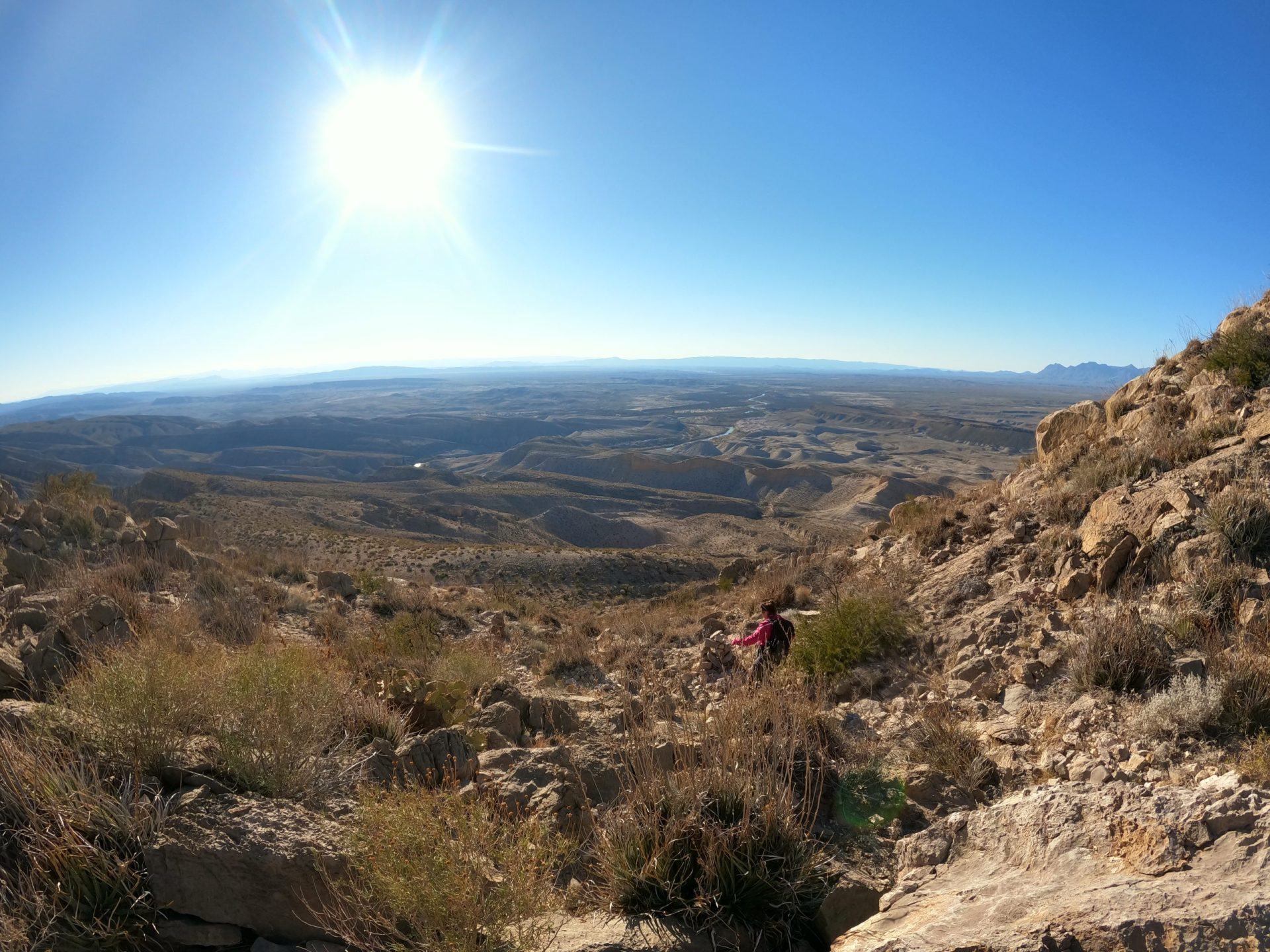You’re spoiled for choice when camping in Big Bend National Park. There are four very diverse main campgrounds in Big Bend – the Chisos Mountains campground, Rio Grande Village campground, Rio Grande Village RV park, and Cottonwood Campground. There is also a lodge in the Chisos Mountains or you can choose from a number of backcountry campsites spread throughout the park.
Table of Contents
Planning Essentials
Before we get to my complete guide to each of these individual places to stay, let’s get a few ground rules of the way. These are park rules, not my rules, by the way, but personally I think they’re good rules.
No Wood or Ground Fires Allowed
This one is a little uncommon and may disappoint you. Wood and ground fires are strictly prohibited in the park. You cannot light up a campfire and roast s’mores here. Most of the park is a desert, it’s super dry much of the year, and the odds of a small fire becoming a big fire are just too high.
However, you may have a charcoal fire in an above-ground grill as long as you pack your ashes out. Liquid-fuel stoves are also allowed.
Be sure to check the park’s website to make sure there are no burn bans that disallow charcoal grilling, too. In times of drought, the park may only allow camp stoves.
NO PETS on trails, in the river, or off-road
Another important note is that pets are not allowed on trails, off roads, or on the river. And in case you think you can avoid the rangers to get around this one, bear in mind that mountain lions are more than capable of fucking up even the largest dogs. Not a risk I would take.
Ultimately, the rule is that your pet is only allowed to go where your car is allowed to go (roads and campsites, basically), so maybe leave Fido at home for this one.
Book Your Site in Advance
Big Bend is remote and far from one of the most visited national parks, at around ½ a million visitors in a given year. But it still often fills to capacity on holidays and 3 day holiday weekends.
Its busy season is November to April and campsites are often fully booked from January through April. Finding a last minute campsite can be a real pain (ask me how I know). My recommendation: Plan the fuck ahead.
The Chisos Mountains Lodge
Does Big Bend National Park have a hotel? Basically, yes.
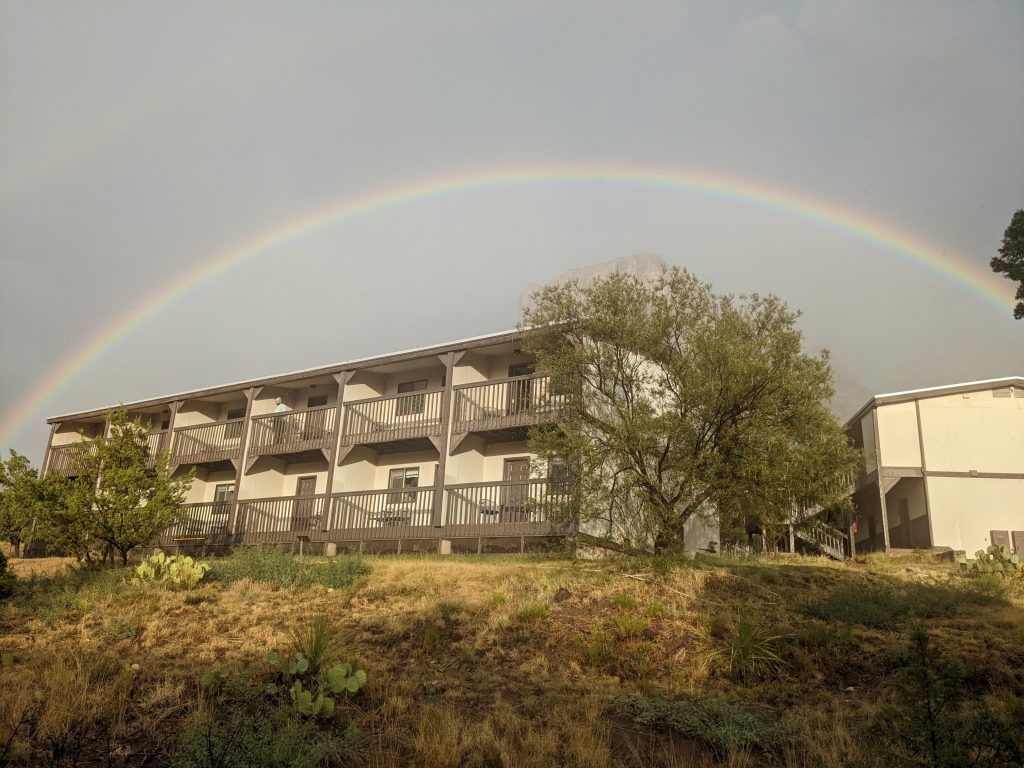
In the heart of the Chisos Mountains, not far from the Chisos Basin campground, Big Bend boasts a full service lodge. Complete with 72 non smoking rooms, A/C, a mini fridge and hot and cold running water, there’s nothing more that you could ask for in a place as remote as this!
Now that’s fucking luxury in a park as remote as Big Bend.
On our first trip to BBNP, everything went awry with our attempt at backcountry camping. It rained cats and dogs on us the first night. Water literally soaked through the bottom of our tent.
The following day, Jon and I were eating dinner at the Chisos Mountains restaurant when we signed into the Wi-Fi to discover that rain was forecast for that night as well. At that point, I’d had enough. We hightailed it back to our campsite, packed the fuck up, and got us a reservation at the lodge.
Thank goodness too, because it definitely rained a lot more that night! Hell, it soaked us pretty thoroughly on the way down the mountain. At that point, the Chisos Mountains Lodge felt like the height of luxury.
You do pay for this luxury, with many of the rooms coming in around $200. Anywhere else, a room this basic for that price would have me pretty upset. But trust me, if you really need (ok, want) this option while you’re out in the wild, it’s well worth the price.
Big Bend National Park Campgrounds
As I mentioned above, there are four different campgrounds spread throughout Big Bend. Read on for a complete guide to each camping option.
Chisos Mountains Campground
Number of sites: 56
Open: year-round
Amenities: flushing toilets, running water in the bathrooms, outlets in the bathrooms, food storage lockers
What it doesn’t have: electricity, running water at the individual sites, showers, laundry.
The Chisos Mountains campground is probably the most popular campground thanks to its location, nestled deep in the heart of the cooler Chisos Mountains at 5,400 feet of elevation.
Here you are near to the visitor center, convenience store, Chisos Mountains Lodge and restaurant, and potable water. You can easily restock on grocery supplies and ice at the convenience store or jaunt up to the visitor center to connect to Wifi.
Now that’s fucking luxury in a park as remote as Big Bend.
You’ll catch breathtaking views of Casa Grande, Emory peak and be able to enjoy the sunrise through “the Window”. You’re also close to some of the best trailheads in the park.
The sites themselves are pretty small and stingy. In reality, some of them would barely fit our 8 person tent and the tent spots themselves are often quite rocky and not always level.
The park recommends that trailers over 20ft and RVs over 24ft not camp here, as the road to get into the campground is narrow and twisty. Remember, if you do have a small trailer, you will not have access to electricity but there is a dump station.
Rio Grande Village Campground
Number of sites: 93
Open: year-round but only 24 campsites are open May 1-Oct 31
Amenities: flushing toilets, running water in the bathrooms, some overhead shelters, food storage lockers, coin operated showers at the convenience store, ice for sale, laundry, wifi (at convenience store), dump station, picnic tables, grills
What it doesn’t have: electricity, running water at the sites themselves
On the East side of the park, this campground is set along the Rio Grande in a grove of cottonwoods and acacia trees. The road to reach the campsites and the roads within the campground are all paved – you can get to this place in a Prius! These sites are slightly more generous than their counterparts in the Chisos Mountains Campground and considerably less rocky.
There is a camp store that has coin operated showers and laundry, as well as basic necessities. This is the only place in BBNP where you can shower, apart from getting a room at the Chisos Lodge.
Note that generators are only allowed in certain campsites (ask a ranger which ones if you want to avoid trouble).
From this campground, you can access the popular Hot Springs trail. If you’re planning to hike, Boquillas Canyon trail, Marufo Vega, Ore Terminal and Strawhouse Trailheads are all within close driving distance. Boquillas border crossing is also close if you’re planning to go south of the border.
There’s also a fully functional RV Park nearby.
Rio Grande Village RV Park
Number of sites: 25
Open: year round
Amenities: full hook ups – water, electricity and sewer connection.
Rio Grande convenience store is located nearby where ice, souvenirs, snacks and propane fill ups (by appointment) can be had. You must call the concessionaire to reserve these sites. No tents are allowed here – it’s for folk in RVs only.
Cottonwood campground
Open: Nov 1-April 30
Number of sites: 21
Amenities: vault toilets, (claims to have) potable water, food storage boxes, convenience store nearby
What it doesn’t have: showers, wifi
Not Allowed: generators, ground fires, wood fires
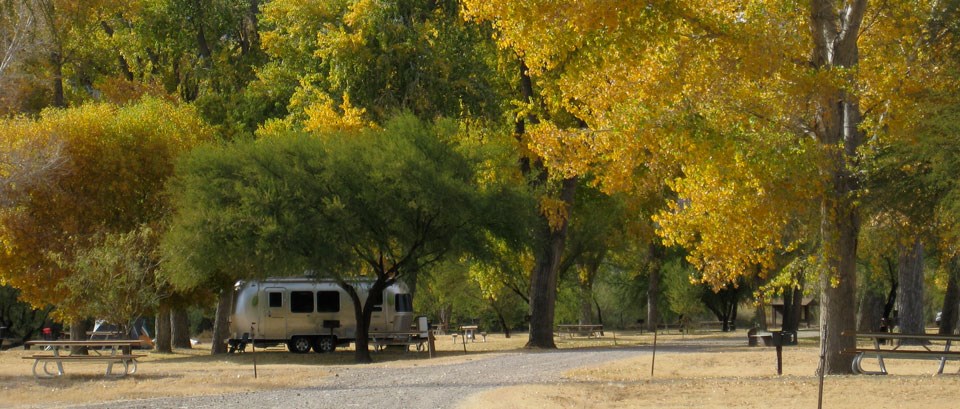
Located on the Ross Maxwell Scenic Drive on the East side of the park, Cottonwood Campground is the least busy campground in Big Bend. Due to extreme summer heat, it is closed May-October. This campground is located near the Castolon Store where you can purchase ice, gifts and camping basics Wednesday-Sunday.
From these campsites, you can access Santa Elena Canyon, the Castolon historic district and the Ross Maxwell Scenic Drive.
Primitive Roadside Campsites
For any Coloradans (Coloradoans?), discovering that “boondocking” or “dispersed camping” in Big Bend is a total no-no may come as a disappointment. However, Big Bend does offer 64 primitive campsites along backcountry roads.
This is the way to get a real glimpse into the heart of Big Bend, as these sites are located in some of the most remote desert areas of the park and may require hours of skilled driving in a high clearance 4×4 car to reach.
The National Park Service defines a high clearance vehicle as: an SUV or truck with at least 15 inch tire rims plus 8 inches of ground clearance from the lowest point under the car (I might have crawled under my Honda Pilot to measure this).
Primitive roadside campsites offer a small flat gravel space to set up camp next to your vehicle. There is no shade, no toilets, and no other amenities. Generators are also a no-no in the backcountry.
You can reserve online up to 6 months in advance at the 23 most popular such campsites. For the remaining 41 campsites along the River Road, Glenn Springs Road, and Old Maverick Road, you must obtain a permit in person at the Panther Junction visitor center or Chisos Basin visitor center. These permits are available up to 24 hours before your first night’s stay.
Good luck…don’t die out there.
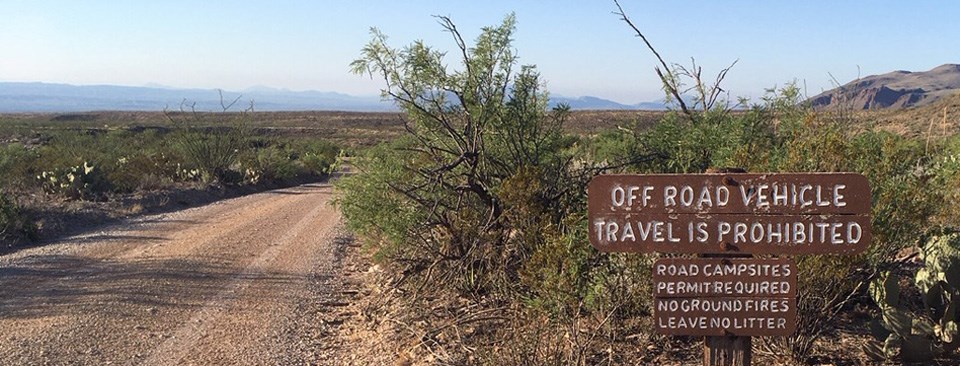
List of Primitive Roadside Campsites along Improved Dirt Roads
Many primitive roadside campsites are located along improved dirt roads that are usually accessible to most high-clearance vehicles – except after rain. After heavy rain, you’re fucked, and might have trouble accessing these campsites even with a 4×4.
Primitive Roadside Campsites— Croton Springs (2 campsites)
Primitive Roadside Campsites— Grapevine Hills (5 campsites)
Primitive Roadside Campsite— Hannold Draw (1 campsite)
Primitive Roadside Campsites— K-Bar (2 campsites)
Primitive Roadside Campsite— Nine Point Draw (1 campsite)
Primitive Roadside Campsites— Old Maverick Road (5 campsites)
Primitive Roadside Campsites— Paint Gap (4 campsites)
List of Primitive Roadside Campsites along Primitive Dirt Roads
These campsites are only for the experienced hiker and skilled driver. The primitive dirt roads are maintained for rugged high clearance vehicles only and 4 wheel drive is a must. On these roads you may encounter rocky, exposed bedrock, deep ruts, and extensive sections of soft sand/mud.
These roads are not a joke and you will likely regret your decisions if you head out to one of these in a sedan, or even a standard (non-4×4, non-high clearance) SUV.
Passenger cars, minivans and RVs cannot take these roads, not even to drive to a trailhead! Rain will quickly make these roads difficult to drive, if not impassable, even for 4×4 vehicles. Always speak with a ranger about current weather & road conditions before attempting.
People have died on these roads when their cars break down and they are unprepared.
Primitive Roadside Campsites on Glenn Springs Road: Robber’s Roost, Twisted Shoe, Glenn Spring, Rice Tank, Chilicotal, and Nugent Mountain
Primitive Roadside Campsites on Old Ore Road: Candelilla, Camp de Leon, La Noria #1-2, Ernst Tinaja, Ernst Basin, Willow Tank, Telephone Canyon #1-2, Roy’s Peak Vista, McKinney Springs
Primitive Roadside Campsites on River Road (east and west): La Clocha #1& #2, Gravel Pit #1-3, Solis #1-2, Fresno, Talley #1-4, Dominguez Spring, Loop Camps #1-2, Johnson’s ranch #1-2, Gauging Station, Black Dike, Buenos Aires #1-2
Backcountry Campsites in the Chisos Mountains
There are also 42 backpacking campsites in the Chisos Mountains area. Most of these require advance reservations, which can be placed up to 6 months in advance. You must camp in designated campsites and obtain a permit. From what I can tell, a “permit” is simply a reservation. You can get these permits at https://www.recreation.gov/camping/campgrounds/10028875.
NPS provides a free handbook for backpacking in the Chisos, and other information, right here.
The backcountry campsites in the Chisos Mountains of Big Bend National Park are:
- Juniper Flat (3 sites)
- Boulder Meadow (5 sites)
- Pinnacles (3 sites)
- Toll Mountain (1 site)
- Boot Canyon (4 sites)
- Juniper Canyon (1 site)
- East Rim (9 sites)
- South Rim (4 sites)
- Colima (3 sites)
- Blue Creek (2 sites)
- Laguna West (3 sites)
- Laguna Meadow (4 sites)
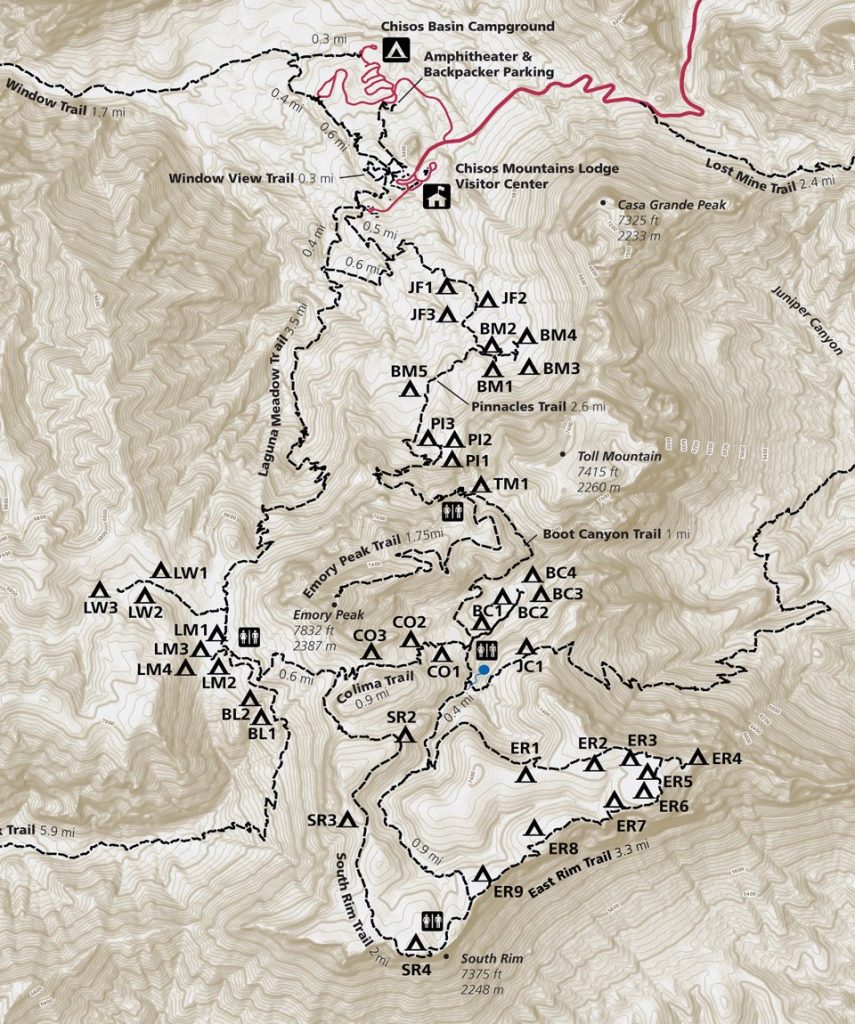
Wilderness backpacking
For the utmost experienced and prepared hiker, Big Bend also has wilderness backpacking, which is permitted in most desert areas of the park. What’s that?
Well, wilderness backpacking is simply hiking out into the desert and setting up camp – after obtaining a permit and while following a few rules along the way, of course. You learn all about it here.
In order to obtain a permit to do desert wilderness backpacking, you will have to give a ranger a detailed itinerary, have all the backpacking equipment needed, and be able to hike at least 30 minutes away from any road in the area you intend to camp. Camping near or alongside the road is strictly prohibited. In addition, you must be at least 100 yards from any trails before setting up camp.
If you’re ill prepared, seem like a newb, or your trip seems inappropriate, the rangers have the right to refuse to issue a permit – and honestly, you should thank them for doing so. They’re probably saving your life.
The park places strict limits on the number of backpackers in each area and all backcountry rules must be followed to the letter. This isn’t church where you’re encouraged to follow the spirit of the law – in the wild, you need to follow the letter of the law, too.
Popular trails from which to wilderness backpack include:
- Mule ears/Smoky Creek Trail
- Chimneys Trail
- Marufo Vega and adjoining trails
- Marisal Rim trail
- Blue Creek Trail
- Juniper Canyon
- Dodson trail
- Elephant Musk
- Outer MOuntain loop
- Mesa de Anguila
Too Long: Didn’t Read;
Use the table of contents links to find what you need; I can’t really sum this one up.
With so many ways to stay in Big Bend, there is something for everyone – from hotel hikers to backcountry adventurers. To learn more, check out the official NPS Big Bend website or stick around and read more of my thorough and honest trail reports, reviews, and Texas camping advice.

